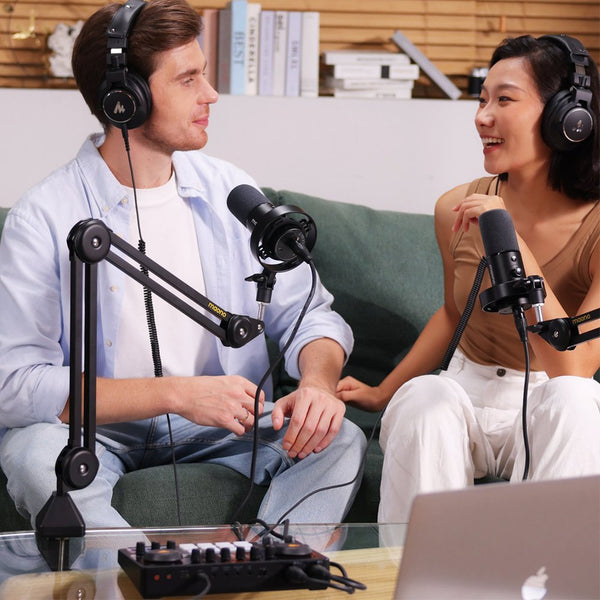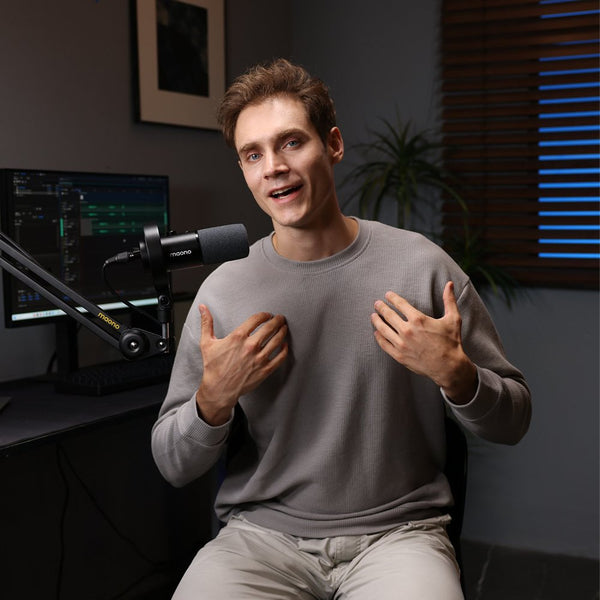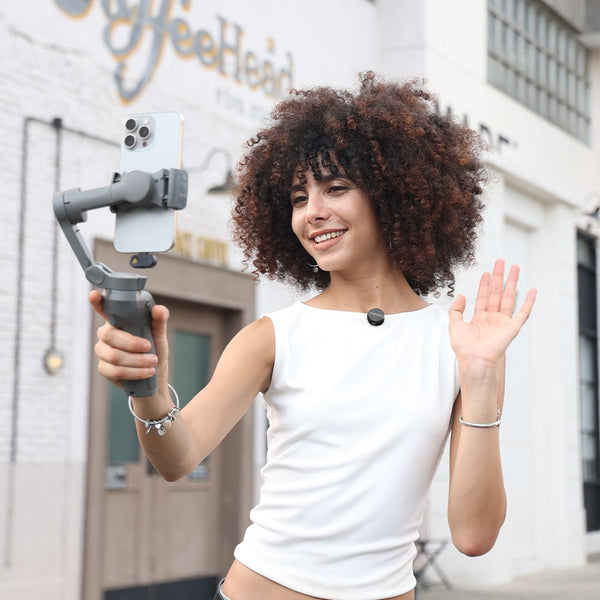Do you want to share your experience and teach fitness classes online but have no idea how to use a wireless microphone? Using a wireless mic is easy, depending on the type of microphone you choose. In this article, we recommend the Maono Wave T5 wireless microphone for its ease of use and other amazing features, such as long battery life and noise cancellation.
Teaching fitness classes—whether online or in-person—requires more than just energy and expertise. Today’s instructors are expected to provide clear guidance, stay physically active, and maintain engaging communication—all at the same time. One tool that can significantly boost your professionalism and effectiveness is a wireless microphone.
Whether you're leading a HIIT session in a gym, streaming a yoga class from home, or filming a Pilates video for YouTube, a wireless mic helps deliver crystal-clear instructions without interrupting your flow.
In this guide, we’ll explore how to teach fitness classes like a pro using a wireless microphone, how to speak clearly while demonstrating movements, and the best tools to elevate your sessions. Let’s dive in.

How to Teach Fitness Classes Like a Pro Using a Wireless Microphone
A wireless microphone is more than a luxury—it’s a game-changer. Unlike handheld mics or wired solutions, a transmitter wireless microphone system gives you freedom of movement, allowing you to instruct while performing exercises without being tethered to one spot or compromising your audio clarity.
For professional instructors, sound quality is as important as the workout itself. Participants need to hear cues clearly and follow along confidently, especially when watching on a screen. Whether you're leading a cardio class or guiding participants through a recovery routine, your mic is your lifeline to engagement and comprehension.
How to Clearly Explain Exercises While Performing Them
Teaching effectively while exercising can be tricky. You’re out of breath, you’re moving, and you’re concentrating on form. Here are some best practices:
-
Use short, clear cues
Say “engage core” or “keep spine neutral” instead of long-winded explanations.
-
Speak rhythmically
Match your cues with the pace of the movement. This helps your class stay on beat and in sync.
-
Demonstrate first, then instruct
Show the movement before the set begins, then offer quick reminders while performing.
-
Use pauses wisely
Take brief moments between reps or sets to elaborate, explain regressions, or offer encouragement.
A wireless lavalier microphone for laptop with good noise suppression and a snug fit (like a clip-on or headset mic) makes it easier to keep talking without sacrificing your workout.
FAQs About Online Fitness Classes:
What are some alternative exercises to sit-ups or crunches?
Sit-ups and crunches aren’t for everyone—especially those with back or neck issues. Luckily, there are excellent alternatives that work your core effectively:
-
Plank Variations:
-
Plank Pull-Through: Start in a high plank position with a dumbbell beside you. Reach under your body with the opposite hand and pull the weight across. Repeat on both sides.
-
Plank with Leg Lift: In a forearm or high plank, lift one leg off the ground while keeping hips steady. Alternate legs to target glutes and core.
-
Bird Dog:
-
Begin on all fours. Extend one arm forward and the opposite leg back. Hold briefly, return to start, and switch sides. This is great for balance, coordination, and spine stability.
These moves not only engage your abdominal muscles but also involve the entire core, improving strength and posture.
What are some effective ways to mix diet tips into a workout class?
Incorporating wellness advice during a class adds value and keeps your sessions holistic. Here’s how:
-
Use transition periods: While changing positions or between circuits, share quick nutrition facts.
-
Keep it actionable: “Add a protein-rich breakfast post-workout” is more useful than a lecture on macronutrients.
-
Create themes: Try “Monday Moves & Macros” or “Wellness Wednesday” to integrate diet tips smoothly into the session.
How long should a mic-based fitness class session be?
The ideal session length depends on the format and audience:
-
15–30 minutes: Best for busy clients, beginners, or focused training (e.g., abs, HIIT).
-
30–45 minutes: Great for full-body routines or balanced sessions with warm-ups and cooldowns.
-
60 minutes: Ideal for advanced workouts, yoga flows, or deeper engagement classes.
Regardless of duration, the quality and clarity of instruction—supported by your wireless lavalier microphone for Mac or PC—matter most.
How do I keep my audience engaged during a virtual or live workout session?
Engagement is the key to retention. Here’s how to keep your fitness sessions dynamic:
-
Use your voice creatively: Inflect your tone to convey energy, encouragement, or calm.
-
Call out names (if live): Personal shoutouts make participants feel seen.
-
Ask questions: “How’s everyone feeling?” or “Ready for round two?” creates interaction—even in virtual formats.
-
Incorporate countdowns or challenges: Keep motivation high with short-term goals.
How can I transition smoothly between exercises and health tips?
Transitions are your opportunity to educate, motivate, and reset. Follow these steps:
-
Use a consistent format: After each round or set, cue a “recovery moment” for hydration or breath control.
-
Plan script segments: Write out quick phrases or tips to match the breaks.
-
Avoid rambling: Stay on-topic and concise to avoid dragging momentum.
Using a wireless lavalier microphone for camcorder or smartphone with hands-free control ensures you can move and speak without losing pace.
Technical FAQs About Tools for Vlogging:
How can I get audio from a wireless microphone to my camera?
Many wireless mic systems include a receiver that plugs into your camera’s mic input via a 3.5mm jack or adapter. Here’s a basic setup:
-
Connect the receiver to your DSLR, mirrorless, or smartphone with a compatible cable.
-
Clip or wear the transmitter mic, then sync audio levels.
-
Test your levels before filming—speak at workout volume and check playback.
Wireless systems like the Maono Wave T5 offer seamless camera integration and excellent audio fidelity.
What’s the best way to record audio and video simultaneously during a workout session?
To streamline production:
-
Use an external mic connected directly to your camera to capture both video and clear audio in one file.
-
Alternatively, record audio separately using a portable recorder and sync it in post-editing using clap or hand cue.
-
Use platforms like OBS if streaming live—select both your video source and wireless mic input.
How do I wear a wireless mic comfortably while working out?
Comfort and security are crucial:
-
Use clip-on or used wireless lavalier microphones that wrap securely over your ears or around your neck.
-
Secure transmitter packs in an armband, waistband, or sports pocket.
-
Choose sweat-resistant gear and test placement to prevent rubbing, slipping, or mic noise.
How do I keep the mic from picking up heavy breathing or wind noise?
Fitness classes can get intense, and audio interference is common. Here’s how to minimize it:
-
Use foam windscreens or furry windproof on the mic head.
-
Position the mic away from your mouth or nostrils—clip it near your chest or collarbone.
-
Use a noise gate feature (if your system or editing software allows) to cut low-level breathing.
-
Choose cardioid or omnidirectional mics to focus on your voice, not background noise.
What wireless microphone is best for teaching fitness classes?
The Maono Wave T5 is an excellent choice. Here’s why:
-
Compact and lightweight for comfort during movement.
-
High-quality audio transmission with minimal latency.
-
Dual transmitter system for co-hosts or music overlays.
-
Up to 9 hours battery life, & 30 hours with the charging case, ideal for multiple sessions.
-
USB-C and 3.5mm support, making it compatible with cameras, smartphones, and PCs.
-
Comes with noise-reducing accessories e.g. windproof and a portable case—perfect for instructors on the go.

Conclusion
Mastering the art of teaching fitness classes is a blend of performance, education, and connection. With the right wireless lavalier microphone for laptop or camera—like the Maono Wave T5—you gain the ability to teach clearly, move freely, and create a professional experience for your clients whether they’re in a gym or joining from their living room.
From building confidence while speaking and demonstrating exercises to answering technical questions about sound setup and recording, this guide has walked you through the essentials of becoming a pro-level instructor.
So lace up your sneakers, clip on your mic, and hit play. With the power of great sound and solid instruction, your fitness classes are about to go to the next level.



